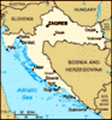Advertisement
Published: April 12th 2015
What a gift to get up Saturday morning and go out on our balcony and take in the beautiful view of the Adriatic, where the water is as still as glass and the white steeple of St. Euphemia is set against a brilliant blue sky. We are so very lucky. We walked along the water's edge all the way to Hotel Eden, where we were to meet the car rental people. He was there right on time and we picked up our little Chevrolet Spark. Curtis was a little miffed that the lady who had rented a car also got the red Fiat!!! He asked her how she got it and she replied, "I don't know. I just rented a car online and this is what they gave me." Green with envy he said he has always wanted to drive one. She smiled broadly and stated, "Everyone always says Fiat's are for females. I am happy to hear a 'real' say he wants to drive one." Puffing out his chest in response, he accepted the keys to the Spark and we were on our way to explore Istria.
Driving along the winding local roads gives you such a wonderful view
of the Istrian region as opposed to taking the major highway. the first place on our agenda was to go to Dvigrad. Our little car climbed the steep and hairpin turn road. As we crested the hill we could see this abandoned hilltop town in the distance. Dvigrad is the remains of a town that is spread over two hilltops. It did have a population of 2000 people at one time but due to plage and war only three families lived there in 1714. When the parish moved to nearbly Kanfanar, the town died out. Dvigrad is the largest complex of medieval building remains in Istria. We wandered through the ruins where there were remnants of buildings, gates, old streets and a 14th century tower. This once thriving town is literally falling down. Waling around, you could imagine how this town once looked, as people and carts roamed through the streets.
Leaving there, we continued on the winding roads, meeting tons of cyclists pedalling there way up and down the challening and steep roads. Next we arrived at Sveti Lovrec, a town with preserved fortifications, several towers and town gates. The most ancient part of the walls dates back
to the 11th or 12th century. It was the centre of government for country estates when under Venetian rule. We walked into St. Martin church the stone-paved town square, it's bell tower and pillar of shame.
Next it was off to Porec, one of the first Roman colonies in Istria. It still has the same street layout as it did in those days. The Basilica is a Unesco World heritage site. The old town is beautiful and you can walk along the town walls on a beautiful walkway, entering the walls in a few different places.
Our last stop was in Novigrad Cittanova where parts of the Venetian wall have survived, as well as several churches and gothic houses. We walked along another beautiful stone path with the sea on one side and the town walls on the other. The water was rougher here and splashed straight up along the edge of the walkway. We wandered into the Cathedral of St. Pelagius, a beautiful church with a stunning wooden chair for the priest to sit upon. It was quite unique.
On our way back we crossed the road that goes over the sea and as we came
down over the hill we could see a beautiful bay far below. We made our way down to the Lim Channel, which is a huge flooded canyon which resembles a Norwegian fjord. Oysters and clams are cultivated here and the restaurants there specialize in seafood. The elongated bay is 12km and is encircled by steep, forested hills. Some of them are over 200m high. Also here is Romauldo's Cave, one of the oldest inhabitants of early man in Istria. It is located along the Lim Channel on the steep slope of Mt. St. Martin. It is also the home to a bat colony and underground beetles. Curtis was on his own for this one! The cave is 120m above sea level. He began the 360m walk, the rocky goat path that went up the side of the mountain to the cave entrance. Scaling this, he arrived at the cave, only to find it locked! Disappointed he decided to run the whole way back, whereupon he realized his cardio is not quite what it used to be! As his lungs burned he managed to say, "You were right not to go because you would have hated every minute of the climb,
up and down!". This cave is 150 m long and has 7 chambers once used Stone Age hunters. Legend has it that it was also the home of St. Romuald, who lived there as a hermit for two years.
Heading back to Rovinj we stopped at one of the several roadside stands that sell Istrian olive oil, wine, and honey. We purchased a bottle of wine and made our way back to our apartment. As the sun was setting we walked down to the promenade to sit by the water. The red ball slowly melted into the water, and dusk settled around the beautiful hilltop town.
Advertisement
Tot: 0.195s; Tpl: 0.012s; cc: 11; qc: 63; dbt: 0.0891s; 1; m:domysql w:travelblog (10.17.0.13); sld: 1;
; mem: 1.2mb














